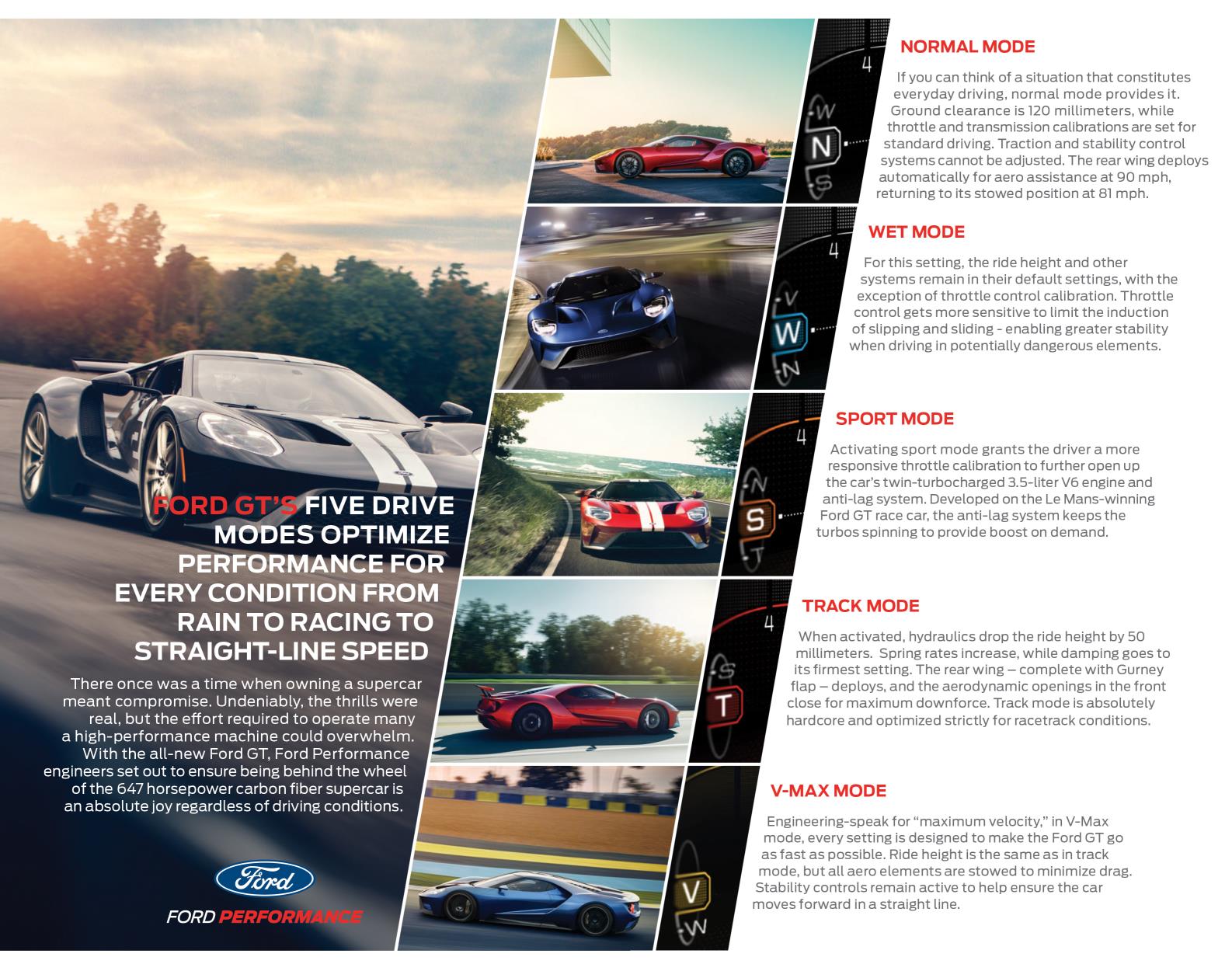
- All-new Ford GT comes equipped with five drive modes that enable the driver to quickly tune performance to almost any condition – from street to track to inclement weather
- Modes include Normal for everyday touring, Wet for driving in the elements, Sport for more spirited ventures, Track for racing and V-Max for maximum straight-line speed
- One simple turn of a dial quickly changes aerodynamic, engine, stability control and shift characteristics, as well as ride height and more of the Ford GT
DEARBORN, Mich., Mar. 28, 2017 – There once was a time when owning a supercar meant compromise. Undeniably, the thrills were real, but the effort required to operate many a high-performance machine could overwhelm. With the all-new Ford GT, there is no such tradeoff. Ford Performance engineers set out to ensure being behind the wheel of the 647 horsepower carbon fiber supercar is an absolute joy regardless of driving conditions.
Five modes enable Ford GT to attain ideal performance – whether on-road driving on a nice summer day, contending with rain and other elements, or aggressively pursuing its limits on a closed circuit. The drive modes include:
- Normal, for everyday driving
- Wet, for driving in the elements
- Sport, for more spirited ventures
- Track, for racing
- V-Max, for maximum straight-line speed
Ford Performance heard the criticism from drivers about just how difficult it could be to get the most out of their supercar. “We focused on simplifying the experience,” says Derek Bier, Ford GT manager. “Optimizing this car for just about any situation was critical, because ensuring owners always enjoy driving it was a top priority.”
Each mode is specially tuned for a unique driving environment. “Switching the setting changes electronic, mechanical and aerodynamic elements,” explains Nick Terzes, Ford GT engineering supervisor. Leveraging learnings from the Ford GT racing program, Ford Performance gave each mode a unique instrument cluster display, with elements prioritized to enhance the overall driving experience.
All of this means that with the simple turn of a knob on its F1-inspired steering wheel, the all-new supercar can switch nearly instantaneously from canyon-carving road machine to fully functioning race car tuned for maximum speed and downforce.
Ford GT also features an advanced, yet easy-to-use launch control system that provides optimal traction for the perfect launch every time. Designed for track use, it’s available in all modes except “Wet”. The system is activated through the steering wheel controls in the instrument panel menu and, when activated, a white “LC” appears in the cluster. At this point the driver holds down the brake with their left foot and fully depresses the gas with their right foot. When ready, the “LC” turns green and the driver lifts their left foot and the GT launches off, quickly hitting speed.
Normal mode
If you can think of a situation that constitutes everyday driving in a Ford GT, Normal mode provides it.
Ground clearance is 120 millimeters, while throttle and transmission calibrations are set for standard driving. Traction and stability control systems cannot be adjusted. The rear wing deploys automatically for aero assistance at 90 mph, returning to its stowed position at 81 mph. The wing still deploys as an airbrake if sensors detect aggressive braking.
In Normal and Wet modes, comfort suspension is available. Pressing the comfort button allows the driver to soften the car’s ride on bumpy roads by adjusting compression and rebound in the dampers – without compromising control.
Wet mode
For this setting, the Ford GT’s ride height and other systems remain in their default settings, with the exception of throttle control calibration.
For Wet mode, throttle control is adjusted to limit the induction of slipping and sliding – enabling greater stability when driving in potentially dangerous elements.
Sport mode
Activating Sport mode grants the driver a more responsive throttle calibration to further open up the car’s twin-turbocharged 3.5-liter V6 engine and anti-lag system. Developed on the Le Mans-winning Ford GT race car, the anti-lag system keeps the turbo spinning to provide boost on demand.
For Sport mode, ground clearance remains 120 millimeters, but that’s about all that remains. There’s no longer a comfort feature available, while AdvanceTrac® stability and traction control become driver-adjustable allowing three additional settings.
Additional slip, yaw and oversteer are allowed so drivers can push harder and have more fun sliding the car around. “Driver-demand calibrations get more aggressive – where slight changes in throttle result in faster acceleration,” explains Terzes. “Gear changes are more rapid, while clutches disengage and engage very quickly for maximum acceleration.”
“Drivers can use Sport mode at the track and expect the car to perform very well with this setup.”
Track mode
While Sport mode can be used effectively for many racetracks – especially those that require a higher ride height – Track mode is absolutely hardcore and optimized strictly for race conditions.
With the transmission in park on pit road, a turn of the knob activates hydraulics that drop the ride height 50 millimeters. Spring rates increase, while damping goes to its firmest setting. The rear wing – complete with Gurney flap – deploys, and the aerodynamic openings in the front close for maximum downforce. All of this happens in under two seconds.
“This mode is for track use only,” says Terzes. “Even coming from Sport, control is significantly different – dramatically so. In this mode, every aspect of the car is optimized for track use.”
V-Max mode
Engineering-speak for “maximum velocity,” in V-Max mode, every setting is tuned to make the Ford GT go as fast as possible. Like Track mode, selecting V-Max requires the transmission be set in park. Ride height is the same as in Track mode, but all aero elements are stowed to minimize drag. Stability controls remain active to help ensure the car moves forward in a straight line.
“Ultimately, V-Max mode is designed with a single objective. For the GT to achieve its fastest possible straight-line speed. It works,” says Terzes.
Drive Modes Chart
| Wet | Normal | Sport | Track | V-Max | |
| Use | Driving in wet conditions | Normal driving in dry conditions | Sport driving in dry conditions | Optimized settings for track use (not for street use)** | Optimized settings for achieving maximum velocity (not for street use)** |
| Stability and Traction Control |
Active, cannot be adjusted | Active, but can be adjusted | Active, cannot be adjusted | ||
| Launch Control | Not Available | Available | |||
| Ride Height and Suspension Damping | High with normal damping | High with sport damping | Low with track damping | ||
| Comfort Damping | Available | Not available | |||
| Transmission Calibration | Normal | Sport | |||
| Turbocharger Anti-lag | Inactive | Active | Inactive | ||
| Rear Wing | Active above 90 mph | Active above 70 mph |
Always deployed |
Does not deploy | |
| Air Brake | Activates above 75 mph with moderate braking | ||||
| ** Must be in park (P) to select this mode | |||||

